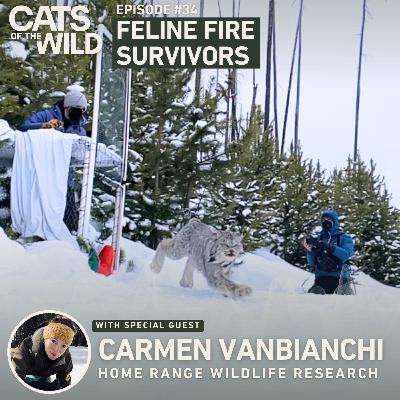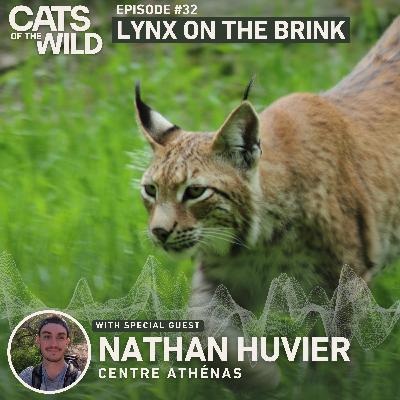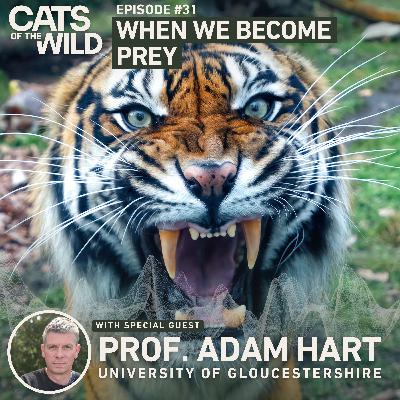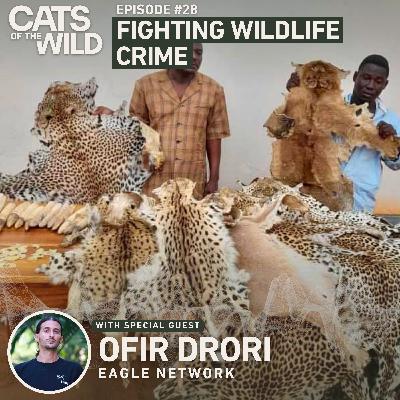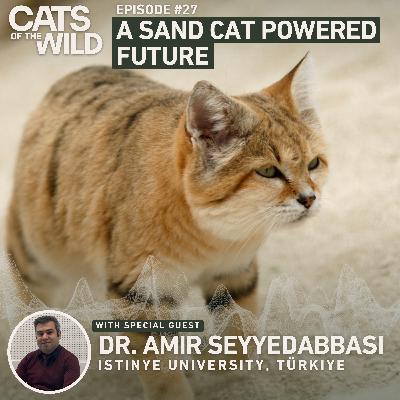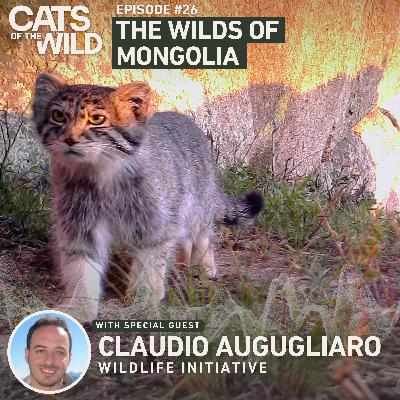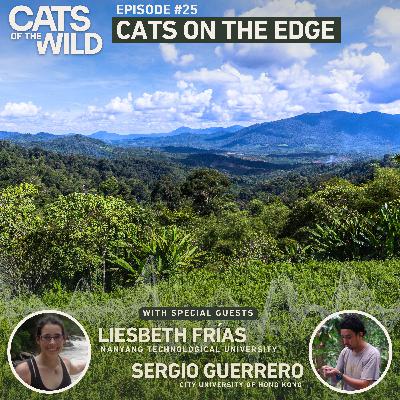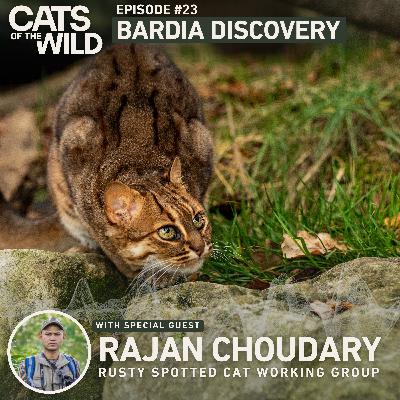Discover Cats of the Wild
Cats of the Wild

Cats of the Wild
Author: Andy Varvel
Subscribed: 18Played: 514Subscribe
Share
© Andy Varvel
Description
Lions, tigers and leopards are just some of the 40 species of wild cat around the world that are under threat. Join me, as we travel to every corner of the globe to hear the incredible stories from the people and communities working to study and protect all species of wild cat.
Wild cat conservation is more than just cats - by protecting cats, we save other species in their ecosystems, we help local communities in their habitats and we conserve huge swathes of precious land across the planet.
Cats of the Wild is an original, not-for-profit podcast by Andy Varvel.
Wild cat conservation is more than just cats - by protecting cats, we save other species in their ecosystems, we help local communities in their habitats and we conserve huge swathes of precious land across the planet.
Cats of the Wild is an original, not-for-profit podcast by Andy Varvel.
40 Episodes
Reverse
Beijing, China - the world's largest capital city was once the traditional habitat of the magnificent North Chinese leopard.
Pushed out from Beijing, these leopards today live in the Taihung mountains in the south west of the capital, however an ambitious project from the China Felid Conservation Alliance seeks to bring these leopards back home to Beijing.
Across successive generations, these leopards are gradually migrating north towards Beijing. But if they succeed in reaching the city, is it prepared to welcome its new wild neighbours?
Guest
Huang Qiaowen, China Felid Conservation Alliance
Dive into the heart of Mexico's Yucatan Peninsula where ancient traditions meet modern challenges. 🐝🌳 In our latest episode, we explore the tropical dry forests of Calakmul, a place where Mayan beekeepers have been harvesting honey in harmony with nature for centuries.
But now, climate change is bringing an unexpected twist to the tale. With water becoming a precious commodity, a conflict brews between the local beekeepers and the majestic wildcats of the region. 🐆💧
Join us as we follow Mariam, Thelma, and Carlos from the Ocelot Working Group who are on the frontlines, fighting to resolve these conflicts. Their mission? To protect the wildcats and preserve the precious beekeeping practices that support over 25,000 families. 🌍🤝
Tune in to hear their story and discover the innovative solutions they're crafting to ensure that people and nature can thrive together for generations to come. 🌱🐾
Guests
Mariam Weston & Thelma Arenas, Ocelot Working Group
When we think about the illegal wildlife trade, we think of the fur of tigers, the ivory of elephant tusks and the scales of pangolins - but even small wild cats are traded illegally in many countries around the world.
In the porous border region between Myanmar and the Indian state of Mizoram, wildlife biologist Amit Kumar Bal stumbled upon a trade of small wild cats from the Murlen National Park in India, across the border to Myanmar - a global hub for the illegal wildlife trade.
After three years of living in one of the small villages bordering the park, Amit has completely eliminated the hunting of small wild cats - but that's just one village - and now Amit is trying to replicate this success in every village all throughout Mizoram.
Guests: Amit Kumar Bal
In 1965, Yukio Togawa, a Japanese novelist found himself drawn to the whispers of a wild cat unknown to science. He set sail for the untamed wilderness of Iriomote Island and brought this wild cat - the Iriomote Cat to the world's attention.
Togawa inadvertently sparked a conversation about the future of Iriomote Island - a delicate balance between the unspoiled wilderness that needed protection and the essential infrastructure that the island's communities required.
Now, his legacy lives on through his daughter, Kumi. Inspired by her father's passion and dedication, she continues his work, striving to conserve the Iriomote Cat and its habitat. This is their story, told by his daughter, a tale of conservation conflict and the enduring bond between a father, a daughter, and the wild cat that brought them together.
Guest
Kumi Togawa, Japan Tiger & Elephant Fund
Links
Japan Tiger and Elephant Fund
Wildfires have always been a natural hazard ingrained in the history of the forests across Washington state in the US Pacific Northwest, but in recent years their impact has grown more severe, with longer-lasting and more intense blazes pushing this region's fragile ecosystems right to the very brink.
Amongst the wildlife that call these forests home, is a subpopulation of the Canada lynx, a medium-sized species of lynx that ranges across Alaska, Canada and some northern areas of the US.
With each devastating wildfire, the Canada Lynx's future here grows more uncertain - their once familiar territory now fragmented, altered and their survival now in a race against time.
Guest
Carmen Vanbianchi - Home Range Wildlife Research
“Hey all you cool cats and kittens!”
Do you recognise this catch phrase at all? Of course you do, it's Carole Baskin - co-founder of the non-profit sanctuary Big Cat Rescue in Tampa, Florida.
Whilst many people may have only recently heard about Big Cat Rescue through Netflix's 'Tiger King', the organisation has been caring and protecting wild cats for over thirty years. Carole, and her husband Howard have also been tireless advocates for ending private ownership of big cats in the US, resulting in the Big Cat Public Safety Act signed into US law in December 2022.
In March 2023, Big Cat Rescue made a huge announcement - announcing that all the remaining cats at the centre would be relocated to Turpentine Creek Wildlife Refuge in Arkansas and that they would sell the land where Big Cat Rescue is located.
This is far from the end for Big Cat Rescue - it's the start of a new adventure in investing the expected millions from the property sale into conservation projects for cats in the wild.
Guests:
Howard Baskin - Big Cat Rescue
Links
Big Cat Rescue
The Carpathian lynx - a subspecies of the Eurasian lynx. These majestic cats are a symbol of the wild and rugged landscapes of east and central Europe, where from country to country, they roam the mountains and forests. silently hunting for their prey.
Over in France, the fate of these cats is hanging by just a thread. In fact if we do nothing, it's likely they will become locally extinct in just thirty years. Recent research from Nathan Huvier at Centre Athénas, a wildlife conservation organisation in the Jura mountains, has found that these beautiful cats are facing a rapid loss of genetic diversity with just under 150 adult lynxes remaining in the wild in France.
So let's explore the history of the Carpathian lynx in France, dive into the very latest research on their genetic diversity, and discuss how we can all work together to save these cats from disappearing from the French wilderness forever.
Guest
Nathan Huvier - Centre Athénas
Links
Centre Athénas
Humans may be the world's top predator - but what happens when the tables are turned and we become the hunted.
For many people around the world, the feeling of being watched stalked or even eaten by a predator such as a big cat is a terrifying reality.
We're working to protect what wild cats we have left and even increase their numbers. But how do we balance this against the complexities of a world where increasingly people and predators live side by side.
In this episode, we'll hear from Professor Adam Hart, author of “The Deadly Balance: People & Predators in a Crowded World”, and explore the spine chilling topic of human predation by big cats and what the future holds as we continue to push into wildlife habitats.
Guest
Professor Adam Hart, University of Gloucestershire
Links
The Deadly Balance: People & Predators in a Crowded World
Adam Hart - Twitter / Instagram
Maybe you're driving on a road right now - even if you're not you're probably not that far from a road - because, roads are everywhere. It's hard to imagine a modern world without roads - and whilst they allow people like us to go almost anywhere in the world - they're also the great enabler for the many threats facing wild cats today such as deforestation, poaching and of course road-kill
What we don't talk about though - is how the roads themselves divide our precious planet into millions of tiny pieces - irreversibly splitting-up populations of wildlife. So in this episode, we'll hear about the impact of roads on wild cats and some of the innovative solutions - such as wildlife bridges, tunnels & AI smart cameras to make roads - a whole lot more cat-friendly.
Guests
Professor Darryl Jones, Griffith University
Links
A Clouded Leopard in the Middle of the Road
Singapore is one of the smallest countries on the planet, and its rapid rise from a small trading settlement to a bustling modern metropolis has destroyed 95% of its historical forests, driving the extinction of many species of animals. The islands were once home to the Malayan Tiger and the Indo-Chinese leopard and today, there is just one species of wild cat left in Singapore - the leopard cat - with around 50 individuals estimated to be in the wild.
Whilst the leopard cat may be relatively common in some other countries, for Singaporeans, protecting this cat - their last wild cat - is incredibly important. So in this episode, we're going to meet Vilma D'Rozario and Marcus Chua from the community-run Singapore Wild Cat Action Group to learn more about the leopard cat and how they engage Singaporeans to help protect and save their last wild cat.
Guests
Vilma D'Rozario - Singapore Wild Cat Action Group
Marcus Chua - Lee Kong Chian Natural History Museum
Links
Singapore Wild Cat Action Group
Cover Image Credit: Marcus Chua
In Central & West Africa wildlife crime and corruption was rampant - and yet not a single individual had ever been prosecuted. It's in these fragile landscapes where lions are on the brink of extinction, leopards are under threat and other endangered species such as the western black rhino, gorillas and elephants could soon disappear.
So when a young activist discovered the lack of any real enforcement or action against wildlife crime in Cameroon, he began a journey to become the first NGO in the region to directly fight wildlife crime & corruption.
Almost twenty years later, they now operate in nine countries and incredibly have helped arrest and jail over 3000 wildlife traffickers in West and Central Africa. So in this episode, we'll explore how to fight wildlife crime & corruption and how the wild cats of West & Central Africa need our help - now.
Guest:
Ofir Drori, EAGLE Network
Links
EAGLE Network
Kamérimètre (Prod. By P1ague E1even & Zubo) - Cameroon Hip Hop Music
This episode is unlike any I've done before! We're taking a journey into computational science and mathematics and how the sand cat has inspired a new algorithm that could improve artificial intelligence, civil engineering, scheduling, smart routing, supply chains, and even aerospace engineering.
My mind was blown when I read this research paper - and to be honest, it is an extraordinarily complex topic. But together we're gonna explore how the sand cat and the natural world around us is having an impact on some of the most cutting edge technology on our planet. We'll meet the sand cat, an enigmatic small cat native to the deserts of North Africa and the Middle East, and of course the big brain behind this algorithm, Dr. Amir Seyyedabbasi to help explain the maths, the science and algorithms that are already powering our future.
Guests
Dr. Amir Seyyedabbasi - Software Engineering, Istinye University, Türkiye (Link to Papers)
Mongolia - an epic expanse of rolling grasslands, unforgiving desert and rugged mountains. It's also the home of one of the more unusual wild cats on this planet - Pallas’s Cat or the manul.
Since 2020, it's been been listed as "Least Concern" in the IUCN Red List - but if we look deeper, it's quickly evident that we do need to be concerned about the Pallas’s Cat - particularly in Mongolia.
Today we'll meet the Italian scientist on the ground who's using innovative camera trapping techniques to discover the real story of the Pallas's Cat in the wild of Mongolia.
Guest: Claudio Augugliaro, Wildlife Initiative
Links
Wildlife Initiative
Pallas's Cat Videos - Wild Missions
Borneo is a treasure trove of biodiversity and home to one of the oldest rainforests in the world.
It’s also the epicentre of the palm oil industry and so these precious and fragile ecosystems have been ripped wide open, creating opportunity for disease transmission between wildlife, people and their domestic animals.
So what does this mean for the endangered wild cats of Borneo like the Sunda Clouded Leopard and the Flat-Headed Cat?
Guests: Sergio Guerrero (City University of Hong Kong) & Liesbeth Frías (Nanyang Technological University)
Links: Health at the Edge Project
Over 6,000 kilometres from Moscow in the Far East of Russia is the remote and harsh habitat of the Amur Tiger - also known as the Siberian Tiger. It is one of the largest cats in the world, and there is estimated to be around 400 remaining in the wild. The largest threat for the Amur tiger is poaching - but there's really only one way to truly understand how and why poachers poach - and that's to talk to the poachers directly.
And so American wildlife criminologist, Allison Skidmore had a proposal for her university - to go and live in these hunting communities in Far East Russia for months at a time to find out first-hand the REAL extent of the threat of poaching for the Amur Tiger.
Is it a crazy story? Absolutely. It's a story that shows true courage and an unrelenting ambition to learn more about this threat so conservation actions can be taken in the future.
Links
Leave Them Wild
One day in 2012, Rajan Choudhary, a naturalist from Bardia National Park in Nepal was guiding an American tourist in his jeep through the park. Game drives are common in this park with the park home to elephants, tigers, dolphins and many other species.
It was late and as they were returning to the hotel - all of a sudden, in the distance on the right-hand side, about ten metres into the forest - he saw this kind of light in the darkness. Now when you're driving at night, you might have noticed that the eyes of animals or people can reflect the light as tiny little beacons.
So they stopped and reversed back to where they saw this light and gazed into the forest. Rajan borrowed this guest's camera - a DSLR with a long lens - to get a better look - it was a cat, a very small cat - but he wasn't sure what species he was looking at.
So what did Rajan and his guest see that night exactly? Listen to the latest episode of Cats of the Wild - link in bio or find it in your favourite podcast app
Follow the Rusty Spotted Cat Working Group on Instagram @rustyspottedcat.rscwg
#rustyspottedcat #wildcatconservation #wildcats #naturepodcast #wildlifeconservation #wildlife
On February 26, 2019 - the Big Cat Public Safety Act was introduced to the US House of Representatives - in its official summary, it's a bill that revises the restrictions on the possession and exhibition of big cats - species of lion, tiger, leopard, cheetah, jaguar, or cougar or any hybrid of such species, including to restrict direct contact between the public and big cats.
The introduction of this bill was the result of years of advocacy and campaign work from animal organisations such as the International Fund for Animal Welfare, Big Cat Rescue and Born Free USA - and yet today, almost three years later - the bill still isn't law in the US.
So in this episode, we're going to explore the issues with big cat ownership, how it impacts the conservation of cats in the wild and importantly what are the next steps for the Big Cat Public Safety Act.
This episode features Devan Schowe from Born Free USA
Links
Born Free USA
Documentary - The Conservation Game
Happy New Year! Not a normal episode - just a quick thank you and how you can support Cats of the Wild!
Get in touch @catsofthewildpodcast on Instagram or andy@wildmissions.com
Nepal - a mountain kingdom and home to twelve species of wild cat including the tiger, snow leopard and Eurasian Lynx but today we're talking about a small cat - the fishing cat in the Western Terai region of Nepal.
Ganesh Puri is a wildlife and forest ranger - and he saw first-hand the conflict between the fishing communities of this area and the fishing cat - whose numbers are thought to be less than two hundred here.
So Ganesh started the Western Terai Fishing Cat Project and has built connections in these communities to protect the fishing cat and improve the livelihoods of these fishing communities.
This is the story of a man with a big dream for a small cat in a small part of a small country.
Links
Western Terai Fishing Cat Project
Instagram - Western Terai Fishing Cat Project
The Western Terai Fishing Cat Project is supported by the Fishing Cat Conservation Alliance, Small Wild Cat Conservation Foundation, Panthera and the Mohamed bin Zayed Species Conservation Fund.
The Sunda Tiger is one of two subspecies of tiger - and today they can only be found on the Indonesian island of Sumatra. There's less than four hundred left in Sumatra's forests and time is running out before they become extinct in the wild.
As deforestation and illegal hunting continue throughout Sumatra, what hope is there for the long-term survival of the Sumatran Tiger? In this episode we chat to Leif Cocks, founder of the International Tiger Project about the work they are doing in Indonesia and the different ways that you can help save the Sumatran tiger today.
Links
International Tiger Project






